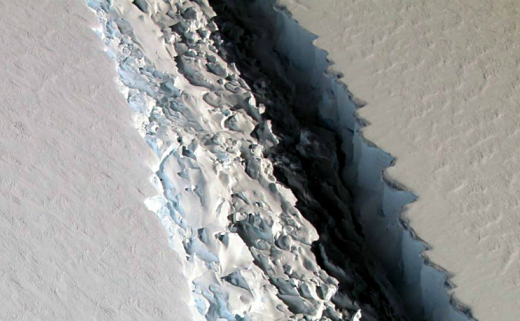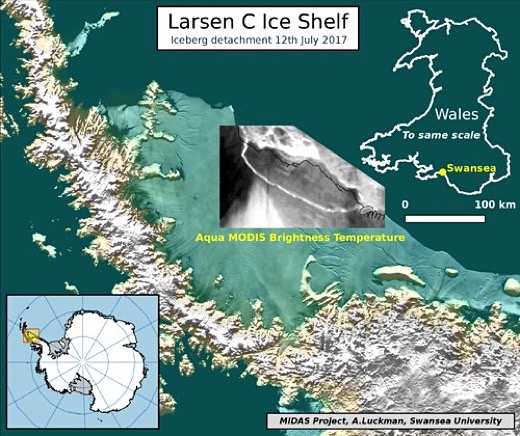SUBHEAD: A trillion ton iceberg as big as Delaware leaves the Larson Shelf for places unknown.
By Jake Johnson on 12 July 2017 for Common Dreams -
(https://www.commondreams.org/news/2017/07/12/maps-will-be-redrawn-massive-exxonknew-iceberg-breaks-antarctica)

Image above: NASA photo of the split in ice on the Larson Shelf as giant berg calve from Antarctica. From original article.
One of the largest icebergs on record—weighing in at approximately one trillion tonnes and encompassing an area comparable in size to the state of Delaware—has finally broken away from the Larsen C Ice Shelf, an event that has long been anticipated by scientists monitoring West Antarctica through satellite imagery.
"The calving occurred sometime between Monday 10th July and Wednesday 12th July 2017, when a 5,800 square km section of Larsen C finally broke away," Project Midas, a U.K.-based research group investigating the effects of climate change on Antarctic ice, reported on Wednesday.
In a statement, Professor Adrian Luckman of Swansea University—the lead investigator of Project Midas—said that he and his team will continue to monitor both the impact of this calving event on the Larsen C Ice Shelf, and the fate of this huge iceberg."
"The remaining shelf will be at its smallest ever known size," Luckman added. "This is a big change. Maps will need to be redrawn."
While scientists acknowledged that it is unclear whether this particular event was caused by a warming climate, they argued that it could be "a sign of changes to come."

Image above: Map of the larson Ice Shelf with inset B&W image of break area showing white break line of creating new 60km long berg. Note iceberg is as long as Wales is wide. From original setback.
"Certainly the changes that we see on ice shelves, such as thinning because of warmer ocean waters, are the sort [of changes] that are going to make it easier for these events to happen," Twila Moon of the U.S. National Ice and Snow Data Center said in an interview with the Guardian.
Brenda Ekwurzel, director of climate science and senior scientist at the Union of Concerned Scientists, echoed Moon's argument, noting in a statement: "This is likely a harbinger of the pace and size of future ice shelf breaks in the Antarctic Peninsula."
"It's concerning that the ocean and air temperatures around the Larsen C Ice Shelf are so warm," Ekwurzel concluded. "Ocean warming could affect other ice shelves in Antarctica that are holding back massive ice sheets. Scientists, aware of these processes, are likely to adjust sea level rise calculations, reflecting higher levels arriving sooner than now projected."
Anticipating the break-off, climate activists have in recent days insisted that the event should be tied to the activities of fossil fuel companies. As Common Dreams reported, 350.org has called on the U.S. National Ice Center to "name the Larsen C iceberg #ExxonKnew."
"With one of the world's biggest ice shelves at a breaking point, this destruction should bear the name of its greatest perpetrator: Exxon," Aaron Packard, 350.org's climate impact coordinator, said in a statement.
Following the news that the iceberg had finally split from the Larsen C Ice Shelf, commentators echoed Packard's remarks while using the event as an opportunity to slam President Donald Trump for withdrawing the U.S. from the Paris climate accord.
.
By Jake Johnson on 12 July 2017 for Common Dreams -
(https://www.commondreams.org/news/2017/07/12/maps-will-be-redrawn-massive-exxonknew-iceberg-breaks-antarctica)

Image above: NASA photo of the split in ice on the Larson Shelf as giant berg calve from Antarctica. From original article.
One of the largest icebergs on record—weighing in at approximately one trillion tonnes and encompassing an area comparable in size to the state of Delaware—has finally broken away from the Larsen C Ice Shelf, an event that has long been anticipated by scientists monitoring West Antarctica through satellite imagery.
"The calving occurred sometime between Monday 10th July and Wednesday 12th July 2017, when a 5,800 square km section of Larsen C finally broke away," Project Midas, a U.K.-based research group investigating the effects of climate change on Antarctic ice, reported on Wednesday.
In a statement, Professor Adrian Luckman of Swansea University—the lead investigator of Project Midas—said that he and his team will continue to monitor both the impact of this calving event on the Larsen C Ice Shelf, and the fate of this huge iceberg."
"The remaining shelf will be at its smallest ever known size," Luckman added. "This is a big change. Maps will need to be redrawn."
While scientists acknowledged that it is unclear whether this particular event was caused by a warming climate, they argued that it could be "a sign of changes to come."

Image above: Map of the larson Ice Shelf with inset B&W image of break area showing white break line of creating new 60km long berg. Note iceberg is as long as Wales is wide. From original setback.
"Certainly the changes that we see on ice shelves, such as thinning because of warmer ocean waters, are the sort [of changes] that are going to make it easier for these events to happen," Twila Moon of the U.S. National Ice and Snow Data Center said in an interview with the Guardian.
Brenda Ekwurzel, director of climate science and senior scientist at the Union of Concerned Scientists, echoed Moon's argument, noting in a statement: "This is likely a harbinger of the pace and size of future ice shelf breaks in the Antarctic Peninsula."
"It's concerning that the ocean and air temperatures around the Larsen C Ice Shelf are so warm," Ekwurzel concluded. "Ocean warming could affect other ice shelves in Antarctica that are holding back massive ice sheets. Scientists, aware of these processes, are likely to adjust sea level rise calculations, reflecting higher levels arriving sooner than now projected."
Anticipating the break-off, climate activists have in recent days insisted that the event should be tied to the activities of fossil fuel companies. As Common Dreams reported, 350.org has called on the U.S. National Ice Center to "name the Larsen C iceberg #ExxonKnew."
"With one of the world's biggest ice shelves at a breaking point, this destruction should bear the name of its greatest perpetrator: Exxon," Aaron Packard, 350.org's climate impact coordinator, said in a statement.
Following the news that the iceberg had finally split from the Larsen C Ice Shelf, commentators echoed Packard's remarks while using the event as an opportunity to slam President Donald Trump for withdrawing the U.S. from the Paris climate accord.
.
No comments :
Post a Comment